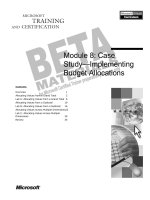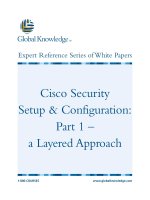Tài liệu Network Security Case Study pdf
Bạn đang xem bản rút gọn của tài liệu. Xem và tải ngay bản đầy đủ của tài liệu tại đây (183.73 KB, 5 trang )
A security breach has just occurred on your corporate network. It could be a virus or worm
that is spreading quickly; it could be an unauthorized wireless access point that was just
plugged into the network; it could be an insider logging into the corporate mainframe and
stealing intellectual property.
The reality is that every Internet-connected network will come under attack eventually and,
unless your enterprise is extremely unusual, one of those attacks will eventually succeed.
Okay, now what? How will your network staff (or security staff if you’re lucky enough to
have one) deal with these and other threats?
This case study examines how one company used eTelemetry’s Locate product to deal
with three different security incidents that occurred during a single week.
Sarbanes-Oxley Compliance
Since this company is publicly traded, it is required to maintain ongoing compliance with
the Sarbanes-Oxley Act of 2002. In order to meet its compliance obligations, the com-
pany implemented eTelemetry’s Locate product as part of its security infrastructure and
controls.
Locate provides the company with additional layers of se-
curity controls or “defense-in-depth” by identifying unau-
thorized users on the network, unauthorized access points,
and users agged by internal IDS systems.
Locate also provides a way to assess the effectiveness
of the company’s security controls as required by the Act
through the historical records of user-to-IP address mapping. This historical mapping is
critical for effective auditing, assessment, and forensics analysis of the company’s secu-
rity systems.
Company Background
The company in this case study, like many companies, has a network that has grown
over time to meet the ever-changing needs of the users. The company headquarters is
located in the suburbs of Washington, DC. It is a campus environment with three buildings
and 800 users. There are regional ofces in Philadelphia with approximately 200 users,
Pittsburgh with 175 users, Atlanta with 350 users, and Boston with 475 users for a total
of 2,000 employees.
All the remote ofces are connected to headquarters via WAN. All of the ofces have at
least one wireless access point and
several of the ofces have three or
more. Each ofce has its own local
Internet connection.
The headquarters campus supports
an older IBM mainframe that runs several legacy applications, including the accounting
Locate also provides a way
to assess the effectiveness
of the company’s security
controls.
Case Study
Network Security Case Study
system. The mainframe is accessed by a variety of staff at headquarters and in each of
the regional ofces.
The vast majority of the workstations are of the Windows variety (2000 and XP). There are
a small percentage of Linux workstations but the exact number is unknown. The graphics
department uses Macs and most are located in one ofce. However, a few secretaries in
some of the regional ofces also use Macs.
Static IP addresses are typically assigned to common resources and DHCP is used for
workstations. When the network was originally designed, IP subnets were assigned to dif-
ferent ofces and departments. However, over time and as the network grew, this subnet
organization has broken down. Over the last several years IP subnets have been as-
signed and reassigned without any regard to department or location.
The networking staff has employed all of the standard security practices one would expect
to nd at most organizations of this size. All connections to the Internet are protected by
rewalls and network intrusion detection systems. All of the workstations have virus-scan-
ning software and a central console is used to push out signature updates. Workstations
and servers are generally kept up-to-date with patches and service packs.
Security Incident #1: Virus Infection
Scenario
The rst security incident of this week began on Tuesday evening when the network ad-
ministrator received an alert from the central virus console reporting that approximately
ve percent or about 100 machines had been infected with the latest virus. The virus con-
sole listed the IP addresses of the infected machines.
The Challenge
The network administrator was faced with the challenge of quickly identifying, locating,
and disabling the switch ports of the 100 infected users so that appropriate measures
could be taken before the virus spread throughout the enterprise.
The Solution Before Locate
The network administrator may have tried several different techniques to locate the in-
fected users including logging into and querying routers and switches. Once he located
the appropriate switch or switches, he would then physically go to the switch and identify
the port and trace the wire to the workstation. This process would have been even more
difcult if the workstation happened to be located in a regional ofce.
This process is unproductive, costly, and time consuming. Additionally, it assumes some
empirical knowledge of the network architecture. A new network administrator who did not
possess knowledge of the network topology would
have a much more difcult time locating the infected
workstations.
It can take up to 45 minutes per workstation for a
potential total of 75 hours to locate and identify the
infected users using this approach.
The Locate Solution
The network administrator simply logged into the Locate web console and looked up the
IP addresses of the infected workstations. He was presented with the name, location, and
phone number of the infected users. He was then able to immediately call each of the
users, notify them of the situation, and disable their switch port. Appropriate steps were
taken within minutes to x the problem before other workstations were infected. The pro-
cess to identify and locate all 100 users took less than 10 minutes.
Appropriate steps were taken within
minutes to fix the problem before
other workstations were infected.
The process to identify and locate all
100 users took less than 20 minutes.
Cost to Identify IP addresses and Switch Port
Although it is nearly impossible to assess all of the costs associated with virus attacks, the
immediate cost of locating and removing viruses can be easily quantied. Assuming the
network engineer’s yearly salary is $75,000 and he spent 75 hours searching for the in-
fected workstations, the loaded labor cost of responding to this incident would have been
approximately $3,750.
Using Locate the network engineer was able to identify the workstations in approximately
10 minutes for a total cost of approximately $6.00. Because the network engineer was
able to locate the workstations quickly, further infection was avoided resulting in additional
time savings and a signi-
cant reduction in risk to
the rest of the company’s
workstations.
The approximate cost sav-
ings to the company to re-
solve this one virus infec-
tion of 100 workstations
was $3,750.
According to network-pro-
tection rm Internet Se-
curity Systems (ISS), the
number of security events
detected by companies in
the rst quarter of 2003
jumped nearly 84 percent over the preceding three months. Based on this trend and the
seemingly continuous supply of new virus and worm threats, most companies can expect
multiple attacks each year. If we assume that this company is attacked ve to six times
within a year, the immediate savings directly resulting from Locate may be as high as
$22,500 annually. Of course the savings will potentially be higher since this number does
not include the more difcult to quantify costs such as lost worker productivity and poten-
tial data recovery costs.
Security Incident #2: Rogue Wireless Access Point
Scenario
A salesperson that frequently holds meetings in a conference room near his ofce was
frustrated by the lack of available network connections for meeting participants. He de-
cided to pick up an inexpensive wireless access point at his local electronics store. On
Wednesday morning he unboxed and plugged the wireless access point into an available
network connection in the conference room. To his amazement, he was able to connect to
the network with his wireless card. The salesman didn’t consider that the conference room
was next to the parking lot, making the access point available to the public.
The Challenge
What the salesperson had unwittingly done was opened up an unsecured channel directly
into the company’s network, bypassing all of the perimeter security including rewalls and
intrusion detection systems. Anybody with a wireless network card in proximity to the con-
ference room could have gained access to the network. Furthermore, the network could
have been accessed from the parking lot without the need to gain physical access to the
building.
The Solution Before Locate
Prior to the installation of Locate there was no easy way for the networking staff to locate
unauthorized wireless access points. Therefore, the network staff would walk the halls
Locate automatically maps people to IP address, MAC address, and switch
ports in real-time and historically.
at the headquarters campus once a week with a wireless equipped laptop searching for
unauthorized access points. This process took one network engineer approximately three
hours per week.
Additionally, network engineers would physically scan the regional ofces once a month.
Each of these scans would take approximately two hours.
The Locate Solution
With Locate running on the network, the network administrator was instantly alerted to
the rogue wireless access point. Upon notication, the network administrator was able to
take immediate action to disconnect the unauthorized access point. The wireless access
point was located and removed from the network less than one hour after it was initially
connected.
Return on Investment
As in scenario #1, we assume the network engineer’s yearly salary is $75,000 and he
spent three hours per week for 52 weeks per year scanning for unauthorized access
points at the headquarters campus. Additionally,
he spent two hours per month physically scanning
each of the four regional ofces. This works out to
252 hours per year spent on this activity for a total
loaded labor cost of $12,600 annually.
Using Locate the network staff is now able to avoid the manual scans since Locate con-
stantly watches for new nodes and access points. By avoiding manual scans, the com-
pany can expect an approximate annual cost savings of $12,600.
Security Incident #3: Insider Theft of Intellectual Property
Scenario
The last security incident of this week occurred on Friday morning. The security adminis-
trator received an alert from the intrusion detection system (IDS) in the Boston ofce that
indicated suspicious activity originating from that ofce directed at the company main-
frame system. The workstation IP address was available in the IDS logs. The security
administrator reviewed the access logs from the mainframe and conrmed that the suspi-
cious activity reported by the IDS needed to be reported to the Vice President of Informa-
tion Security.
The Challenge
The security administrator needed to identify which user was associated with the IP ad-
dress at the time of the suspicious activity. The only information the security administrator
had was the IP address reported by the IDS.
The Solution Before Locate
The security administrator logged into the Locate web console and input the IP address
and dates from the IDS log. Locate looked up the historical information for the time period
in question. He was immediately presented with the name, location, and phone number
of the user who was using the workstation to log into the mainframe. Within seconds the
security administrator had the information he needed to make his report.
The Locate Solution
The security administrator logged into the Locate web console and input the IP address
and dates from the IDS log. Locate looked up the historical information for the time period
in question. He was immediately presented with the name, location, and phone number
of the user who was using the workstation to log into the mainframe. Within seconds the
security administrator had the information he needed to make his report.
The wireless access point was
located and removed less than one
hour after it was initially connected.
Return on Investment
It is clear that the theft of intellectual property is costly and all companies should take steps
to avoid it. Locate speeds time to identify user of offending machine. When two theft losses
are investigated each month at 10 hours per investigation the total loaded labor cost would
be $12,000. Locate can provide historical IP address usage in a matter of minutes.
Summary
The total loaded labor cost for managing security incidents depicted in this document for
a 2000 employee company could potentially reach $47,000. The true value of Locate is
realized by reducing these loaded labor costs to near zero. Locate replaces the labor and
time intensive tasks of identifying, locating and disabling IP addresses and switch ports
with an intuitive, easy to use network appliance.
About Locate
Locate is a network appliance that automatically links network addresses and switch ports
to an individual and their name, location, phone number, and email address. Based on a
proprietary algorithm that analyzes network trafc, eTelemetry’s patented mapping engine
does not require the installation of an agent or client software on the networked device.
The information is accessible through Locate’s web client or it integrates with IT service,
asset, and network management applications via an external API. The network appliance
can be implemented in less than an hour. Locate provides knowledge of who is on the
network at all times, where they are connected, and where they are physically located.
About eTelemetry
eTelemetry is the leader in extracting real-time business information from network activity.
eTelemetry’s innovative products tell you everything about the people on your network,
answering the who, what, where, when, and how much. By applying its proprietary tech-
nology, eTelemetry’s award-winning products provide information leading to increased
productivity, risk identication, reduced costs, greater E911 compliance, improved net-
work efciencies, and insights into how people collaborate. Since 2004, eTelemetry has
been Turning Network Trafc into Business Intelligence™.
41 Old Solomons Island Road • Suite 202 • Annapolis, MD 21401
Phone: 888-266-6513 • Fax: 410-266-0796 • www.eTelemetry.com
Turning Network Traffic into Business Intelligence
Contact eTelemetry









